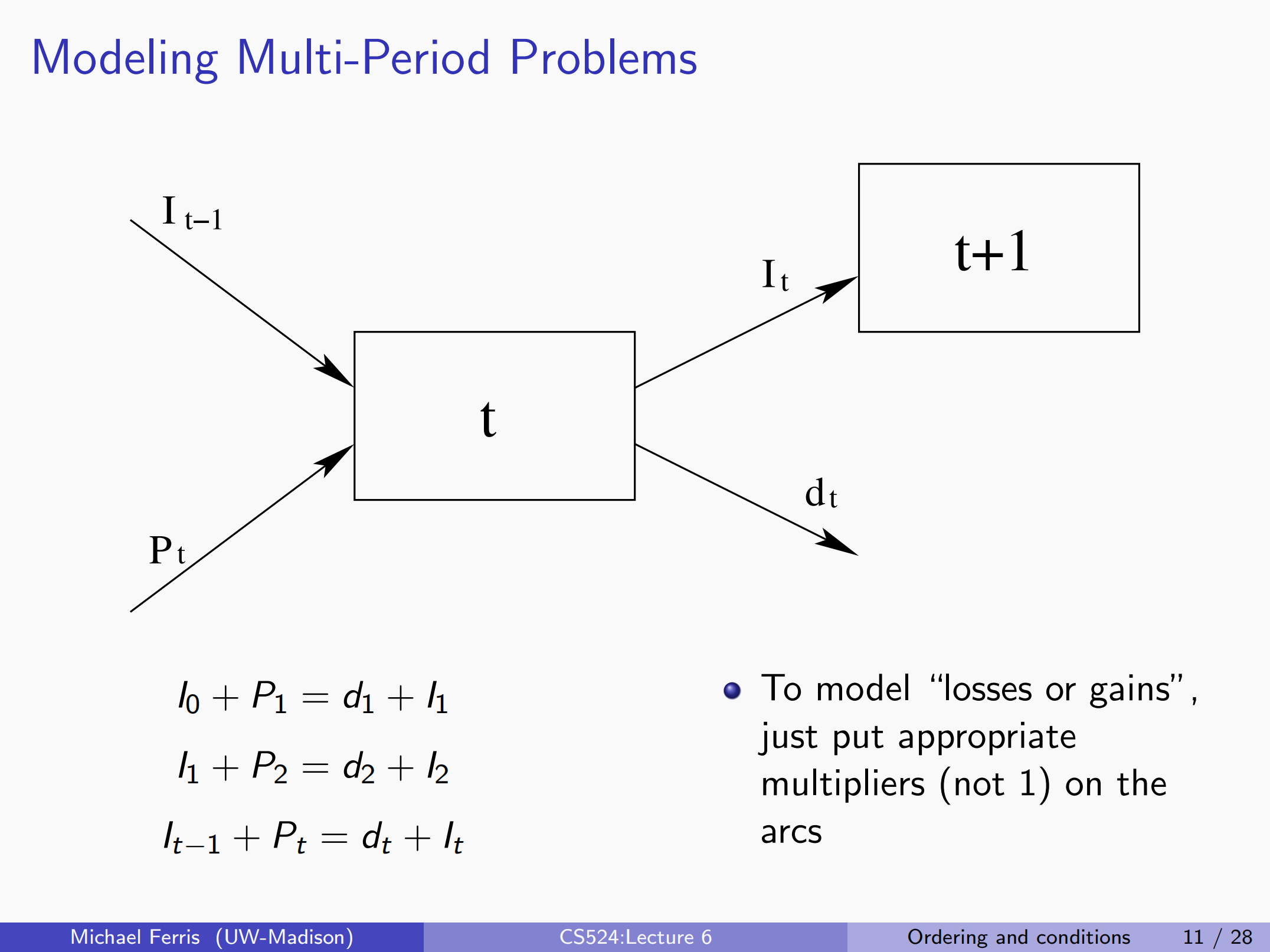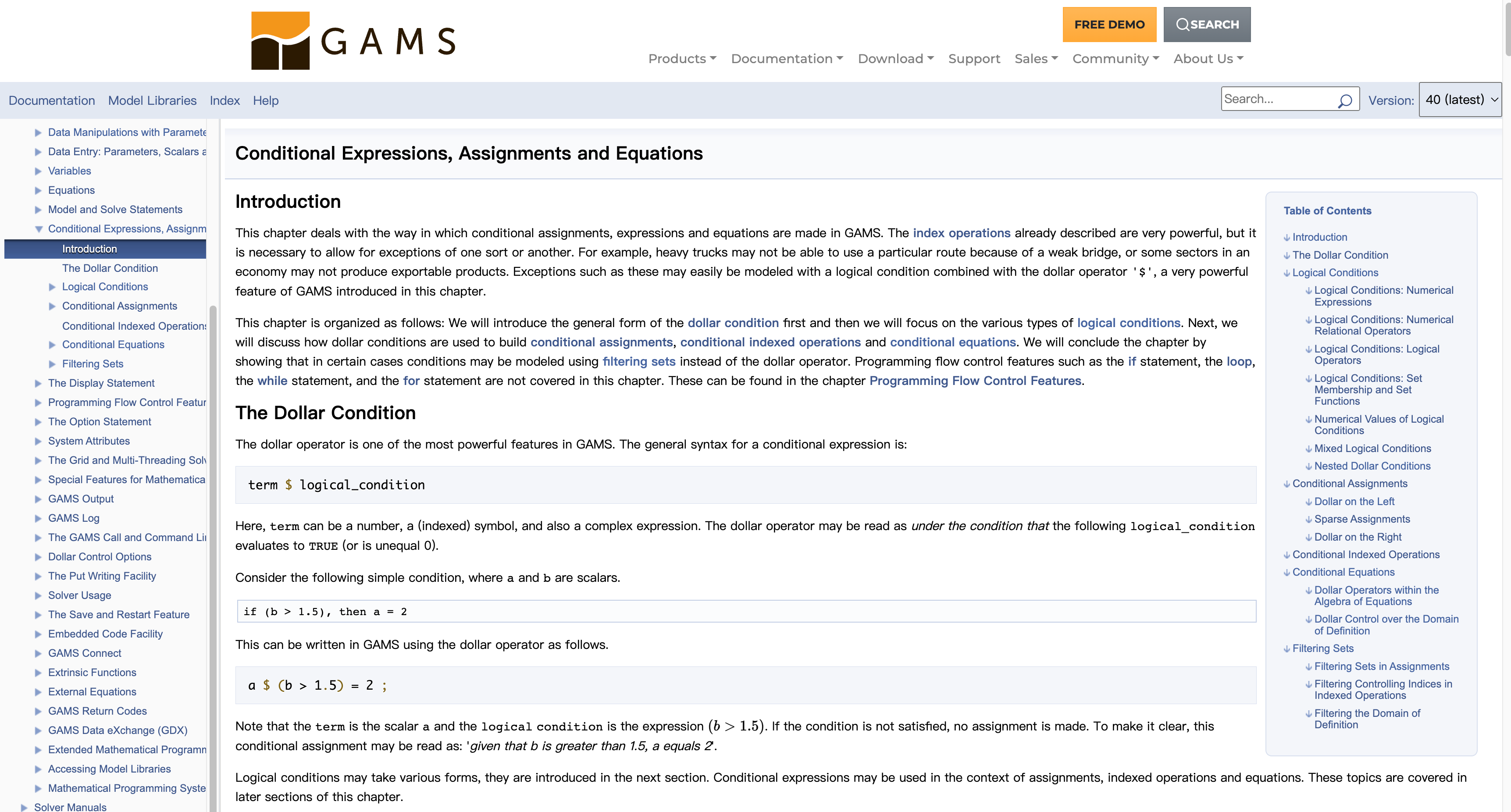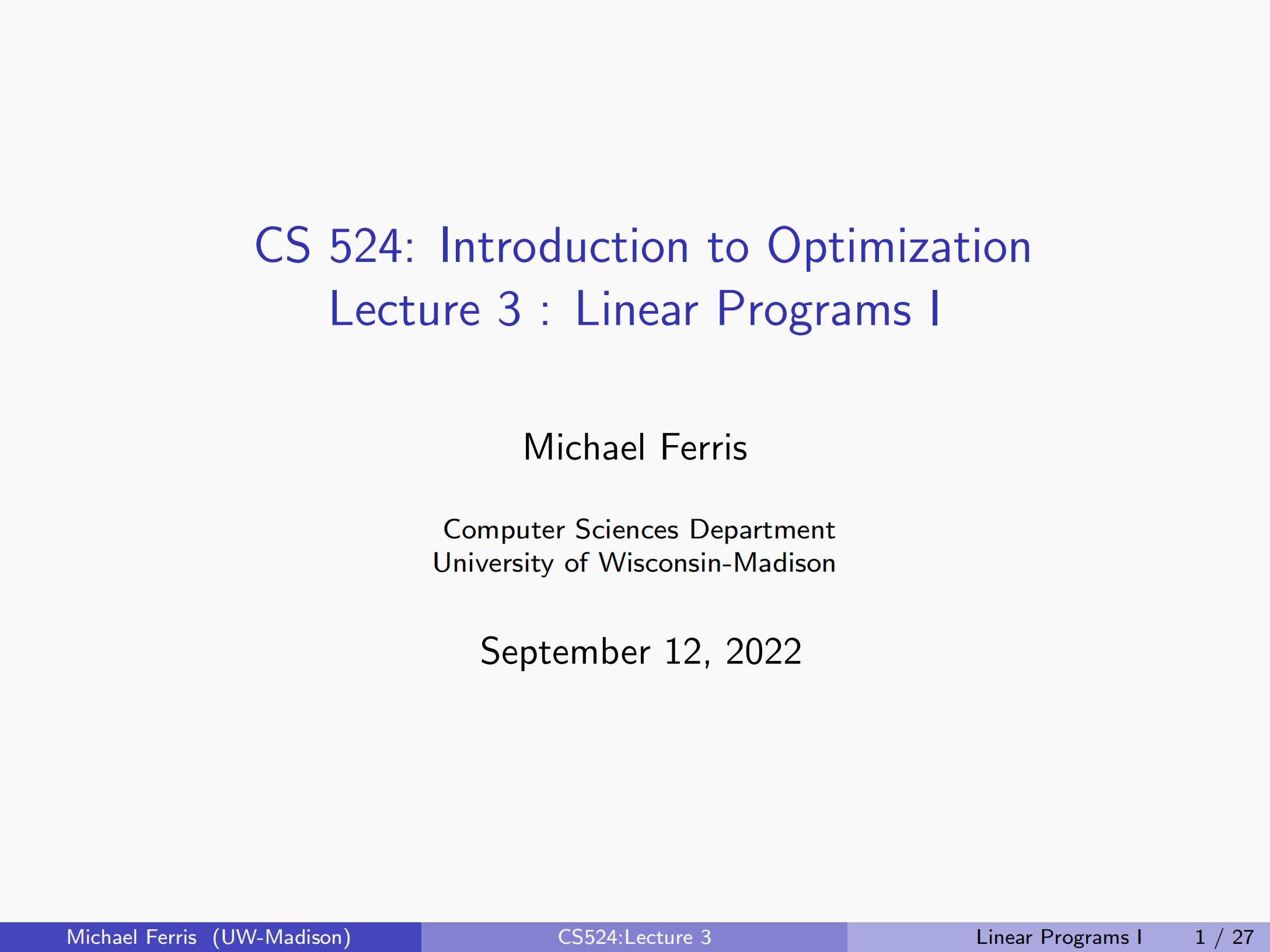
GAMS教程 4:线性模型
在前面的几讲中,我们讲解了GAMS的基础知识,也仅限于GAMS中的基础知识。但事实上,GAMS作为一个工具,我们使用GAMS是为了求解优化问题。
因此,我们关于GAMS,其实要学习的内容包括两部分:
- 第一部分是GAMS的基础知识,包括语法、程序结构等等
- 第二部分是如何使用GAMS求解优化问题的知识
从本节开始,我们就将关注与第二部分,即讲解如何使用GAMS求解优化问题。
本节,我们就将讲解线性模型。我们首先给出线性模型的定义和几个特征(属性),而后再举几个线性模型的例子以及如何用GAMS求解线性模型。
1. 线性模型
A. 定义
线性模型指的是模型中的约束都是线性的优化模型。
用数学语言来描述,就是仅包含线性等式约束和线性不等式约束的优化模型
线性等式约束
线性等式约束的定义如下:
线性不等式约束
线性不等式约束的定义如下
B. 线性模型的特征
线性模型具有以下的特征:
- Proportionality: Inputs/outputs/costs must keep same proportions as levels change
- Additivity: The activites (production amounts. etc), are an additive (linear) function of the input variables
- Divisibility:The activity can be operated at any real level between upper and lower bounds (if any)
2. 使用GAMS解决线性模型
我们接下来举几个GAMS解决线性模型的例子。
A. TopBrass Company
第一个例子就是在前言中介绍的为TopBrass Company制作奖杯的问题
Top Brass Trophy Company是一家专门生产奖杯的公司,这家公司生产两种奖杯:
- 足球奖杯(Soccer)
- 橄榄球奖杯(Football)
卖出一个橄榄球奖杯将会获得$12的利润,而卖出一个足球奖杯将会获得$9元的利润。而生产一个奖杯,两种奖杯分别需要消耗:
- 木质底座:橄榄球奖杯需要4平方英寸大小的木板,足球奖杯需要2平方英尺的奖杯
- 奖杯体:各消耗一个
- 顶端的标志物:橄榄球顶端有一个铜制橄榄球,而足球奖杯顶端有一个铜制足球。
假设目前库存的原材料为:
- 1000个黄铜橄榄球
- 1500个黄铜足球
- 1750个奖杯体
- 4900平方英寸的木板
假设制作的所有奖杯都能够售出,那么
Top Brass Trophy Company能够获得的最大利润是多少?
通常,我们在求解线性问题的时候,最好先列出线性问题的数学模型。
而TopBrass Company问题中的数学模型如下
该优化问题中,决策变量是$f$和$s$,目标变量是$p$,因此我们一共要声明三个变量。
此外,优化问题一共有7个约束。但是7个约束中的四个约束其实都是针对变量$f$和$s$的范围进行的约束,因此对于这四个约束,可以使用变量的属性来进行声明,即.lo和.up属性来声明变量的上下限。所以,我们一共需要声明三个equation。
由于有三个约束,因此就需要三个参数(Parameter)。但是由于f+s的参数都是1,所以其实只需要两个参数即可。
因此,对于这个优化问题我们最终的解如下
* Top Brass 4 介绍了Parameter,Scalar,针对Parameter的Sum操作以及集合中元素的属性
set I/football, soccer/;
free variable profit "total profit";
positive variables
x(I) "trophies";
parameters
profitMargin(I) / "football" 12 , "soccer" 9 /
boardFeet(I) / "football" 4 , "soccer" 2 /
plaques(I) / "football" 1 , "soccer" 1 /;
scalar
plaquesMax /1750/
woodMax /4800/
footballMax /1000/
soccerMax /1500/;
equations
obj "max total profit"
plaq "bound on the number of plaques to be used",
wood "bound on the amount of wood to be used";
obj..
profit =e= sum(I, profitMargin(I)*x(I));
plaq..
sum(I,plaques(I)*x(I)) =l= plaquesMax;
wood..
sum(I,boardFeet(I)*x(I)) =l= woodMax;
model topbrass /all/;
x.up("football") = footballMax;
x.up("soccer") = soccerMax;
solve topbrass using lp maximizing profit;
parameter pct(I) "holds the final percentages";
alias (I,J);
pct(I) = 100 * x.l(I) / (sum(J,x.l(J)));
display pct;
当然,我们可以把两个参数(Parameter)集合起来,组成一个表格(Table)。然后我们就把两个资源限制的公式集合起来。具体代码如下:
$title Top Brass (LP) Example 5.1 of Rardin (1998) (modified)
option limrow = 0, limcol = 0;
option solprint=off;
set I /football,soccer/;
set R /plaques,wood/;
table a(R,I) "Per-Unit resource requirements"
football soccer
plaques 1 1
wood 4 2 ;
parameters
c(I) / "football" 12 , "soccer" 9 /
u(I) / "football" 1000 , "soccer" 1500 /
b(R) / "plaques" 1750, "wood" 4800 /;
free variable profit "total profit";
positive variables
x(I) "number trophies" ;
equations
profit_eq "profit definition"
resource_con(R) "resource limit" ;
profit_eq..
profit =E= sum(I,c(I)*x(I));
resource_con(R)..
sum(I, a(R,I)*x(I)) =L= b(R);
x.up(I) = u(I);
model btb /all/;
solve btb using lp maximizing profit;
parameter pct(I) "holds the final percentages";
alias (I,J);
pct(I) = 100 * x.l(I) / sum(J, x.l(J))
display pct;
B. BigTop Brass
在TopBrass问题中,我们只有两种奖杯、三种资源。如果我们把问题的规模在扩大一下,变成20种奖杯、200种资源呢?此时问题就会非常非常大,我们基本上没法手动解决。
所以在这种时候,我们必须要用GAMS来帮助我们解决问题。
我们可以把数据声明单独写成一个文件.inc文件
* bigtopbrass.inc
set I /football,soccer/;
set R /plaques,wood/;
table a(R,I) "Per-Unit resource requirements"
football soccer
plaques 1 1
wood 4 2 ;
parameters
c(I) / "football" 12 , "soccer" 9 /
u(I) / "football" 1000 , "soccer" 1500 /
b(R) / "plaques" 1750, "wood" 4800 /
;
然后再描述模型的.gams文件中include数据声明文件
$ondollar
$title Big Top Brass (LP)
$include bigtopbrass-1.inc
free variable profit "total profit";
positive variables
x(I) "number trophies" ;
equations
profit_eq "profit definition"
resource_con(R) "resource limit" ;
profit_eq..
profit =E= sum(I,c(I)*x(I));
resource_con(R)..
sum(I, a(R,I)*x(I)) =L= b(R);
x.up(I) = u(I);
model btb /all/;
solve btb using lp maximizing profit;
display x.l;
C. McGrease营养问题
通常人们认为快餐是不营养的,但是快餐的味道却非常好。不巧的是,美国有非常多的快餐。而McGrease问题研究的就是对于麦当劳中的每种食物,我们该如何吃、吃出什么样的配比才能够保证我们营养的同时开销最小。
假设现在一共有以下几种麦当劳的食物(都是美国这里的麦当劳经典款)
QP: Quarter Pounder // 牛肉汉堡
MD: McLean Deluxe // 另一种汉堡
BM: Big Mac // 双层牛肉堡
FF: Filet-O-Fish // 鳕鱼堡
MC: McGrilled Chicken // 麦乐鸡
FR: Small Fries // 薯条
SM: Sausage McMuffiffiffin // 下午茶的香肠
1M: 1% Milk // 牛奶
OJ: Orange Juice // 橙汁
而我们需要的营养有以下几种
Prot: Protein
VitA: Vitamin A
VitC: Vitamin C
Calc: Calcium
Iron: Iron
Cals: Calories
Carb: Carbohydrates
而每种食物各种营养成分的含量、价格以及我们需要的营养成分如下

拿到一个优化问题后,我们首先需要考虑的就是确定决策变量和优化目标,而后才是问题中的优化目标。
McGrease问题中的决策变量就是九种食物每种事物的食用量,而目标变量就是总价,约束就是每种食物提供的营养的总和。
所以上面的优化问题的数学描述为:
我们使用如下的记号,以简化问题
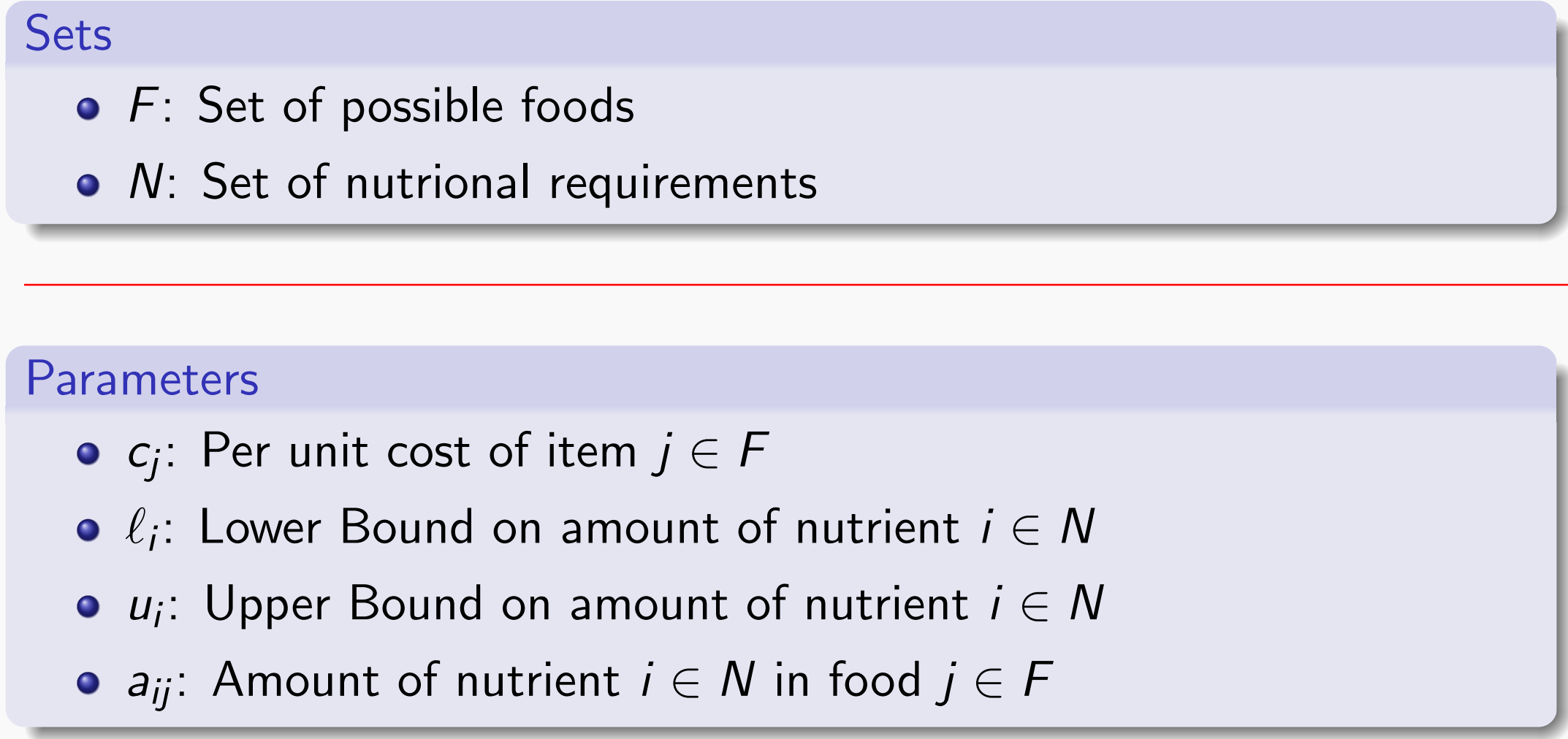
则McGrease问题可以简化为下述形式
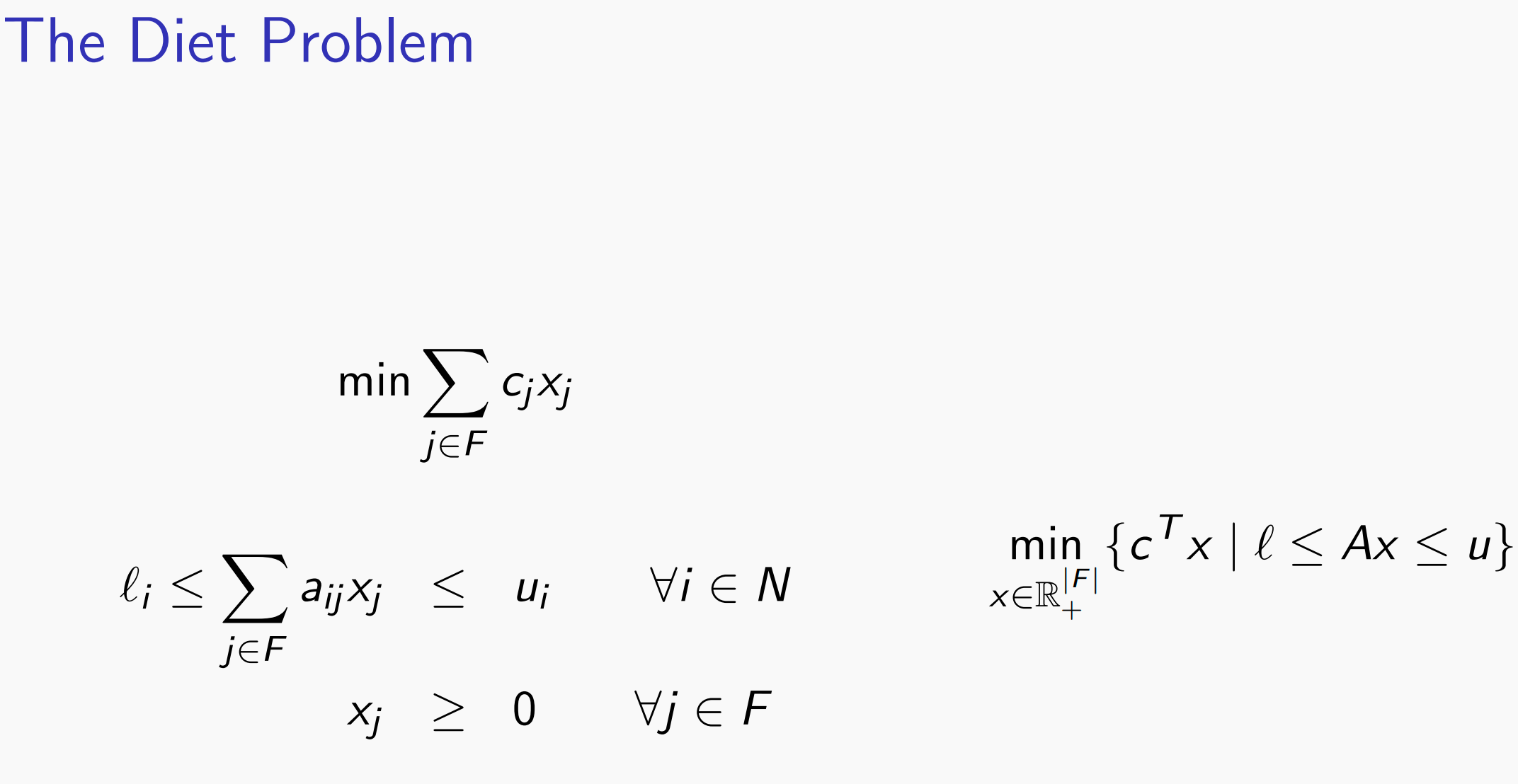
这就是典型的一个优化问题
而对McGrease问题进行求解的GAMS程序为
$title McGreasy Diet Problem
option limrow=10, limcol=0;
set food /QP, MD, BM, FF, MC, FR, SM, 1M, OJ/;
set nutr /Prot, VitA, VitC, Calc, Iron, Cals, Carb/;
table a(nutr,food) per unit nutrients
QP MD BM FF MC FR SM 1M OJ
Prot 28 24 25 14 31 3 15 9 1
VitA 15 15 6 2 8 0 4 10 2
VitC 6 10 2 0 15 15 0 4 120
Calc 30 20 25 15 15 0 20 30 2
Iron 20 20 20 10 8 2 15 0 2
Cals 510 370 500 370 400 220 345 110 80
Carb 34 33 42 38 42 26 27 12 20
;
parameter
min_nutr(nutr) /Prot 55, VitA 100, VitC 100, Calc 100, Iron 100, Cals 2000, Carb 350 /;
parameter
cost(food) /QP 1.84, MD 2.19, BM 1.84, FF 1.44, MC 2.29, FR 0.77, SM 1.29, 1M 0.6, OJ 0.72 /;
free variables
total_cost Total Cost of Daily Diet
;
positive variables
x(food) Number of each type of food to eat
;
equations
cost_eqn Define Objective
min_nutr_eqn(nutr) Minimum Daily Requirement
;
min_nutr_eqn(nutr)..
sum(food,a(nutr,food)*x(food)) =G= min_nutr(nutr) ;
cost_eqn..
total_cost =E= sum(food,cost(food)*x(food)) ;
model diet1 /cost_eqn, min_nutr_eqn/;
solve diet1 using lp min total_cost;
display x.l;




